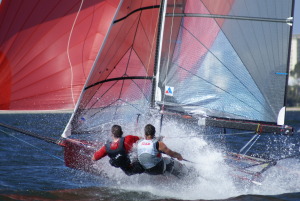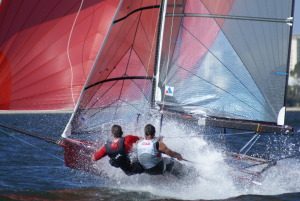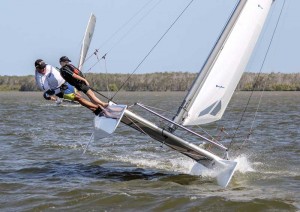
I been sailing small boats since I was a kid in the UK. Probably 10 years old. As the ‘crew’, operating the jib, balancing the boat and at the absolute command of the ‘helm’. Like ships of old, the helm had total control, but fortunately in modern times, flogging has fallen out of favour for any mistakes of the crew. I was very keen and after a suitable apprenticeship, progressed to sometimes being at the blunt end of the boat and being in charge. Controlling the rudder and the mainsail and yelling those deliciously antiquated commands like ‘ready about’ and ‘lee ho’ at the crew to spring them into action. As a teen, I was a fierce competitor in racing and enjoyed considerable success. There are a lot of rules for sailboat racing and you have to know them well and apply the quickly and ruthlessly. So in the melee at the start and the ‘Big Crunch’ at the first mark and a lot of yelling such as ‘starboard!!’, ‘mast abeam!!’ and ‘WATER!!!!” claiming space to round the mark. From afar and out of earshot sailboats racing may look elegant. Up close, it can be fast, vicious with dirty tricks played on the unsuspecting.
Many years travelling the globe, building in Possum Valley and having a family created a large gap in my sailing experience. When my two daughters were quite young, single figures, I bought a little dinghy, a Manly Graduate only 12 ft long but with spinnaker and trapeze and quite lively and took the girls sailing on Lake Tinaroo. Family sailing is a great thing to do because it is a sport where age doesn’t matter all that much. Parents and children can do it together or even compete against each other in races. We had a good time, but my daughters advancing into their teens, expressed a desire for an upgrade, a ‘need for speed’. They wanted a faster boat. OK, lets try a 14 ft skiff. I had been sailing 14 ft boats all my life so how difficult could this be? I should have taken the hint from the guy who sold me the boat who said “don’t go out first time in 20 knot winds”. He had me nailed as a rookie. If you want some idea of how difficult this boat is to sail, google i14 and see video of the disasters that even the experts have. It has an amazing 520 sq ft of sail with the spinnaker up.

14ft skiff doing it’s thing
Our first sail was in strong winds was a disaster being totally out of control. Survival the only issue. In all the dinghys I had sailed before, I knew how to spill the wind and keep upright, but with this monster, for technical reasons about apparent wind, I had to learn completely different reactions and apply them within half a second or it was all over and we were instant swimmers. Also, there had to be perfect coordination between helm and crew, as the crew controlled both the jib and the mainsail when going towards the wind, and the jib and spinnaker when going downwind and the helm takes the mainsail. All this delicate balance while both of us on the trapeze dangling just above the water. The boat reaction time is under a second or you capsize. The crew looks at the sails and constantly adjusts, the helm steers and looks outside the boat looking at the light reflections from the water to guess the wind coming and makes cryptic comments like “gust in five heading”. So I have read a darker patch of water ahead indicating a gust and I think it will come at an angle closer to the boat centerline. We try to make adjustments to the course and sails about 1 second before the gust hits to remain in full control. Holes in the wind are harder to spot on the water and often left us ‘tea-bagging’. That is crashing into the water at 15 knots or more and often being detached from the boat and dragged along by the trapeze wires. I still have the tiller in my hand and the crew the main sheet or spinnikar sheet as we try to right the boat though being in the water a couple of meters away. The helm pulls the tiller to try and fill the sails with wind and the crew pulls in the sheet to do the same. Sometimes we are too successful. The sails fill quickly and we are plucked from the water as the boat becomes upright and we swing and crash into the side of the boat, not always feet first. The thrill and great coordination required was a great bonding experience for me and my daughters to get the boat screaming through the water at up to 30 knots. Actually my phrase “through the water” is not very accurate, it is more like flying and hitting every 3rd wave.
So why am I regaling you with this so many years later? Well, yesterday I was invited by my daughter and partner to sail with them on their recently acquired Nacra 5. A high performance cat. You can google that too if you have any interest. 20 years since I hung up the trapeze harness, I was going to get another go. Fortunately the Nacra is a catamaran and nowhere near as sensitive to balance as skiff. Which is just as well as I found as a septuagenarian, I am stiff and slow. But it was still a great blast to crank myself out on the wire and get the best view of the boat cutting through the water. Its hulls have very fine bows that hardly make a splash at 15 or 20 knots, whereas the skiff directed sheets of water at the crew dangling on the wires.

It was great to get out on the water again, but I doubt I will do it often even when asked. Afterwards I had aches in places I didn’t even know you could get aches, and I want my kids and grandkids to get a bit of the same bonding I got with my daughters. But we did have 3 generations on the boat at the same time.
I have never sailed anything as flat-out hairy as a 14ft skiff. Sailing a 505 single-handed, trapezing a 3-sail reach, with, in my hands, a taped-on tiller extension extension, mainsheet, jibsheet, spinnaker sheet, and a prayer book is the closest I’ve got, possibly, but the 5-0 was very likely much more gentlemanly to sail. It was interesting launching the spinny though. I did once sail the Hesps’ Shark cat, you’ll remember that, with the hydro vanes on each side of both bows to try to stop it pitchpoling. It looks similar to a Nacra 5. I was allowed to take it out on quite a still day, F2-ish, but even so, it moved quite smartly, lifting a hull occasionally, if a little ponderously in those conditions. Roger capsized it over by West End beach, it required several powerboats to right it, and Les sold it not long afterwards.
I have managed single-handed 3 sail down-wind runs on the skiff. You have to haul up the spinnaker on just about a dead run as you have to be in the middle of the boat and steering with your knees. Then click into the trapeze, then ease up to wind to power up as 320 square feet of spinnaker fills with wind and be out on the trapeze when it does. The steering hand traps the mainsheet, but adjusting it is about impossible without desperate use of the teeth. The jib is jammed and beyond control. Accurate steering and the other hand on the spinnaker sheet ready to stop it collapsing is essential. Getting it up while balancing the boat is very difficult. Sailing with all three sails is a challenge, but getting the spinnaker down and safely stowed in some hole, any hole, is a ballet dance to rival swan lake. The scale of the sail twice as much on the skiff, but the tasks just the same on a 505.